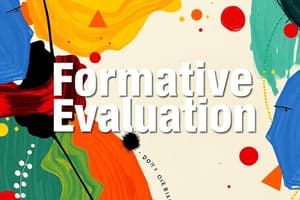Podcast
Questions and Answers
What is the primary purpose of evaluation in an educational context?
What is the primary purpose of evaluation in an educational context?
- To make a value judgement about a student's performance (correct)
- To gather data for statistical analysis
- To create a ranking of students based on their grades
- To enforce strict academic standards
What does criterion-referenced evaluation primarily focus on?
What does criterion-referenced evaluation primarily focus on?
- Subjective interpretations of student behavior
- Comparing students against each other
- General performance trends across a population
- A delimited domain of learning tasks (correct)
What is NOT an aspect of performance assessment?
What is NOT an aspect of performance assessment?
- Assessment of various capabilities through different tasks
- Grading based on standardized testing (correct)
- Structured, on-demand tasks
- Naturally occurring or typical performance tasks
How does evaluation assist organizations or programs?
How does evaluation assist organizations or programs?
Which of the following characterizes norm-referenced evaluation?
Which of the following characterizes norm-referenced evaluation?
Flashcards
What is Evaluation?
What is Evaluation?
Evaluation is the process of making a value judgement about the worth of a student's product or performance.
What is the core purpose of evaluation?
What is the core purpose of evaluation?
It involves gathering information on a person, program, or process to make a value judgement about the effectiveness of what is being evaluated.
What is a criterion-referenced evaluation?
What is a criterion-referenced evaluation?
Criterion-referenced evaluations focus on a specific set of learning objectives and assess if students have mastered those objectives.
What is a norm-referenced evaluation?
What is a norm-referenced evaluation?
Signup and view all the flashcards
What is performance assessment?
What is performance assessment?
Signup and view all the flashcards
Study Notes
Evaluation Overview
- Evaluation is defined as the process of judging the worth of a student's product or performance. This systematically determines the merit, worth, and significance of something, using criteria based on established standards.
- Evaluation aids organizations, programs, projects, and interventions in assessing aims, concepts, proposals, and alternative solutions to improve decision-making and determine the degree of success toward objectives.
- Evaluation involves gathering information on a person, program or project to form a judgment about the effectiveness of what is being evaluated.
Types of Evaluation
- There are three main types of evaluation: formative, summative, and diagnostic.
Formative Evaluation
- Formative evaluation assesses the quality or worth of something during the design or development of instructional materials, procedures, curricula, or programs.
- This type of evaluation monitors student learning progress during or after instruction.
- It is typically administered during instruction to give feedback to both students and teachers regarding success and failure in learning.
- Formative evaluation identifies learning errors that need correction.
- It gives teachers information to modify instruction.
Summative Evaluation
- Summative evaluation assesses the quality of instructional materials, procedures, curricula, or programs at the end of a course/unit.
- This evaluation summarizes strengths and weaknesses of a program's effectiveness.
- This evaluation helps determine the extent to which educational objectives have been met.
- It is often used for grading or placement.
Diagnostic Evaluation
- Diagnostic evaluation is a pre-instructional evaluation to identify student strengths and weaknesses, and the topics that need to be discussed.
- It examines students' prior knowledge about a specific topic/lesson.
- It finds the causes of learning problems and develops remedial action plans.
- It determines the level of student competence.
Approaches to Evaluation
- There are two approaches to evaluation: norm-referenced and criterion-referenced.
Norm-Referenced Evaluation
- This approach compares a student's performance to that of other students who took the same exam/test.
- It measures how a student performs on a set of tasks compared to other students.
Criterion-Referenced Evaluation
- This approach measures a student's mastery of instructional objectives.
- It does not compare student performance to that of others.
- It identifies what a student can or cannot do in a specific instructional program.
- This evaluation method uses a pre-defined criterion.
Types of Performance Assessment
- Structured, on-Demand Tasks: These evaluations give the evaluator control over the task and circumstances, providing clear instructions, and outlining the desired outcomes for the students. This offers control regarding which materials and methods students must utilize.
- Naturally Occurring Tasks: These assessments allow for learning to take place in realistic and authentic settings, like a classroom, playground, or home, often involving groups of students collaborating to achieve a goal. Students are not explicitly told they are being assessed.
Long-Term Projects
- Project assessments are often long-term, requiring various skills and abilities.
- Projects can be completed individually, in groups, or as combined projects where students work together and separately on a task.
Performance Assessment Guidelines
- Identify the Purpose: Define the assessment's goals before designing the task.
- Identify Knowledge, Attitudes, and Required Skills: List the knowledge, attitudes, and skills needed to complete the task.
- Design the Performance Task: Create a task that demonstrates higher-order behaviors.
- Develop Performance Assessment Criteria: Clarify the expectations for the performance.
Studying That Suits You
Use AI to generate personalized quizzes and flashcards to suit your learning preferences.



